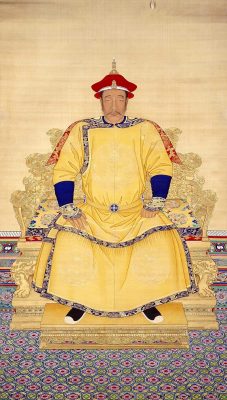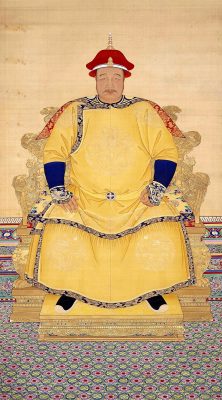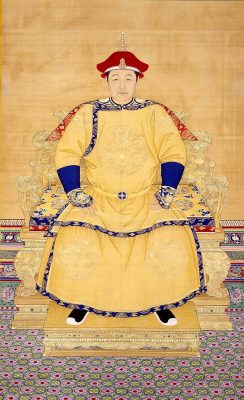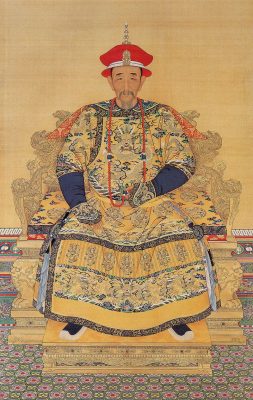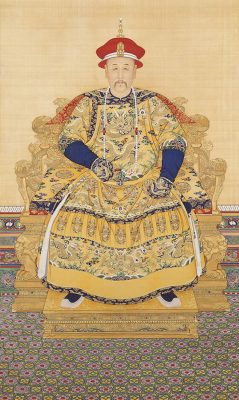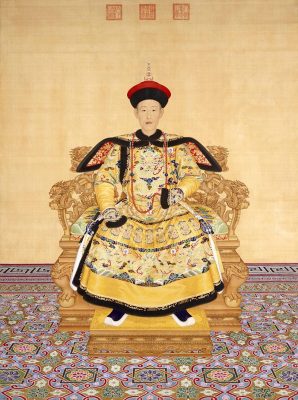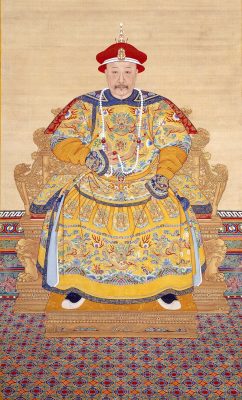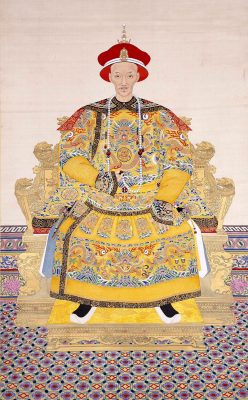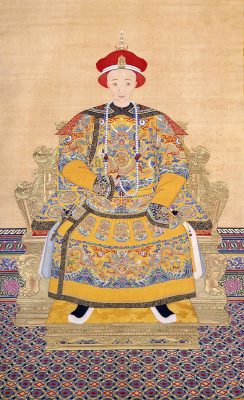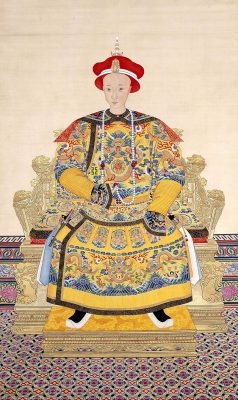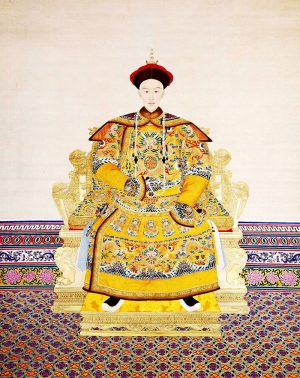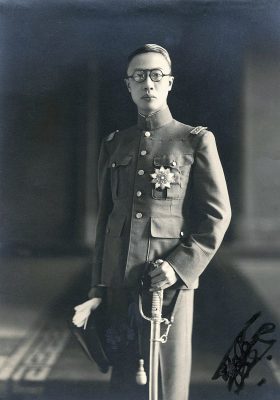The Qing Dynasty reigned from 1644 to 1912 as the last dynasty of Imperial China. The rulers were from the nomadic Manchu tribe who came from the northeastern part of the empire. Their people came from Manchuria and composed only 2% of the entire Chinese population, an ethnic minority.
The most famous Qing dynasty emperors were Kangxi, Yongzheng, and Qianlong. They brought prosperity and stability to China using an autocratic government, with the emperor garnering absolute power over the entire territory.
Nurhaci
Reign: February 17, 1616 to September 30, 1626
Nurhaci was of Jurchen descent, coming from a minority Chinese group from the northeast in an area that would be known as Manchuria. His position as a vassal for the Ming dynasty emperors allowed him to initiate a feud in 1582, an event that he used to gather the Jurchen peoples of Jianzhou. He established the Jin dynasty as its first khan in 1616. This was a nod to the previous Jurchen dynasty that lasted from 1115 to 1234.
The Jin founder created a dynasty that laid the foundation for the Manchu Qing dynasty, battling with the Ming and Joseon dynasties for territories. He unified the Eight Banners system, a social institution that organized the military forces of all Manchurian households at the time. Furthermore, his manifesto called the Seven Grievances opposed Ming rule and convinced the Manchurian tribes to unite against the same cause. Nurhachi’s call for unity brought harmony among the Jurchens, as evidenced in his acceptance of the intermarriage between the Jurchens and Khorchin Mongols, an alliance that strengthened his armies. Conversely, Nurhaci was hostile to the Han Chinese, the ethnic group that composed the majority of China, due to their revolt in 1623.
Hong Taiji
Reign: October 20, 1626 to 21 September 21, 1643
Nurhaci’s 8th son, Hong Taiji, succeeded him in 1626. Despite a defeat on the Jurchens’ end in 1627, the new Jin leader made several changes to further promote unity among his peoples to defeat the Ming. Firstly, he renamed his allied groups the “Manchu,” stylized to appeal to the ethnic group that made up most of the Chinese population, the Han Chinese, who had previously stigmatized the Jurchen name. By 1635, the Mongols joined the Manchus. In this same year, Hong changed the name of the Jin dynasty to the Qing dynasty of China, adopting the title of “emperor” instead of “khan” as his father did. To further strengthen the Great Qing, he followed the Ming dynasty bureaucratic government system and appointed numerous Han Chinese officials to win the hearts of the largest population in China. Hong also tasked a Han division in his army to bolster their weaponry to better combat the Ming dynasty, which had acquired Portuguese cannons.
Hong was exceptional in warfare, heading three banners during his rule. His military prowess won him Manchuria and parts of Ming China with successful raids into Korean territory. The Joseon dynasty submitted to him, making Korea one of Qing’s protectorate territories. Ming China would only be taken shortly after his reign.
Shunzhi Emperor
Reign: October 8, 1643, to February 5, 1661
Shunzhi was the first Qing emperor to control the imperial China proper. He was five years old at the time of his ascension; thus, the regents Dorgon and Jirgalang oversaw his duties in his youth. Dorgon was one of Nurhaci’s sons, while Jirgalang was one of the founder’s nephews.
The beginnings of Shunzhi’s reign had Dorgon in a high position of power, allowing him to continue expansion into Ming-loyalist territories in the southwest. Notably, the regent enforced the queue hairstyle upon male subjects of the dynasty. This left the forehead portion of the head shaved off, the style worn by the Manchus.
However, Drogon, in the bid to be favored by the Han Chinese Drogon also reestablished certain Han traditions. In 1646, he held the Han practice of the civil exams as a way of recruiting imperial officials. Later in 1648, the regent released an imperial decree allowing the Han Chinese to marry Manchus from the banners.
When Dorgon died in 1650, Shunzhi ruled the Qing more actively. Jirgalang replaced Drogon’s loyalists with his own. Shunzhi made several changes in the dynasty that conformed to the Han Chinese style of government. He transitioned back from the structure of the Imperial Household Department to the Thirteen Eunuch Bureaus for his court, allowing Han eunuchs to stay at the imperial court. The emperor learned Chinese and studied the classics, writing the Six Edicts that would serve as the groundwork for the Kangxi emperor’s Sacred Edicts. He continued his expansion into southern China, which would later be taken by the Kangxi emperor.
Kangxi Emperor
Reign: February 5, 1661, to December 20, 1722
Kangxi emperor is one of the most famous Qing emperors known for his prosperous rule, which resulted in the takeover of southern China and several literary and artistic achievements. His reign was the longest of his dynasty; he was on the throne for 61 years. His succession was the result of his mother’s high status compared to Shunzhi’s other wives; this gave him an advantage over his brothers.
Initially, much like his father, Kangxi was controlled by four regents, Ebilun, Oboi, Suksaha, and Sonin. Once Kangxi grew old enough, Sonin and Suksaha were dead. The emperor had Ebilun and Oboi executed.
Early on, Kangxi had the Yellow River and the Grand Canal restored. He also gained control of southern parts of China, providing him with the resources and time to commission several artistic endeavors. Several compilations were made, such as the Encyclopedia on Imperial Command (Yuanjian leihan) in 1710, the Rime Dictionary (Peiwen Yunfu), and the dictionary of Chinese characters called the Kangxi Dictionary.
With openness to Jesuit teachers, also like his father, Kangxi studied several Western subjects such as geometry. He had the Jesuits create the official Chinese calendar and atlas as well. This made for a strong relationship with the Westerners who propagated the Roman Catholic faith, the breeding ground for the Chinese Rites controversy between the Jesuits against the Dominicans and Franciscans.
Yongzheng Emperor
Reign: December 27, 1722, to October 8, 1735
Kangxi emperor was forced to dethrone his second Yinreng from the position of Crown Prince twice due to his heinous crimes. Thus, controversy plagued Yongzheng’s proclamation as emperor due to different factions of the imperial court vying for other sons to succeed Kangxi. However, the emperor’s Imperial Valedictory Will named Yinzhen the next emperor; he was called the Yongzheng emperor.
The fourth son was an effective choice upholding competent governance and thrifty spending, although he only sat on the throne for thirteen years before his death. He centralized the Qing administration by replacing the Grand Secretariat with the Grand Council, the new highest authority that worked with the emperor. Yongzheng also pursued corrupt government officials and had them punished. The Eight Banners obeyed imperial rule throughout the remaining years of the dynasty because he formalized a special palace school where they were molded into submission.
Qianlong Emperor
Reign: October 18, 1735, to February 9, 1796
Qianlong was the second most popular emperor after the Kangxi emperor, chosen by his grandfather himself. He was trained to assume the role from a young age under the respected scholar Fumin. Qianlong’s rule brought the Qing dynasty to the pinnacle of its success, with expansions gaining the empire approximately 600,000 square miles. A love of arts also encouraged literature and visual art to flourish during Qianlong’s reign, with individualists and western-influenced painters creating decadent and traditional pieces. The Complete Library in the Four Branches of Literature (Sikuquanshu) was completed in his time and added to the numerous commissions Qianlong requested. His wide collection of paintings and statues inspired a proliferance of artisans. Architecture, pottery, and jade and porcelain work also became more refined. This complemented Qianlong’s extravagant tea parties that cemented tea culture in China.
Jiaqing Emperor
Reign: February 9, 1796, to September 2, 1820
Qianlong abdicated the throne in 1796, elevating his 15th son, Jiaqing, to the throne. The emperor had to deal with his father’s favorite minister, Heshen, who was a corrupt government official. This period also had the White Lotus Rebellion rise in 1796 and challenge Jiaqing, all while Heshen and his subordinates embezzled the funds that were supposedly for the war. The revolt was shut down in 5 years, exhausting the Qing armies. The start of opium smuggling in China also happened during Jiaqing’s reign, an addictive drug that he attempted to crack down on.
Daoguang Emperor
Reign: October 3, 1820, to February 26, 1850
Jiaqing’s second son, Mianning (later called Daoguang), succeeded him in facing Imperial China in a disadvantageous position from the spread of opium addiction. Western imperialism was starting to affect the Qing dynasty’s economy, consuming the imperial treasury. British attempts to continue selling opium in the empire caused the First Opium War from 1839 to 1842. China was defeated, and the Treaty of Nanking was signed, a dishonorable agreement for the Qing that forced them to open four new treaty ports in Canton for trade with the West. Hong Kong was also ceded to the crown. By the end of his rule, the Taiping Rebellion was only starting.
Xianfeng Emperor
Reign: March 9, 1850 to August 22, 1861
Xianfeng was the Daoguang emperor’s fourth son. His literary intelligence was far above his brothers’, prompting his father to name him the next emperor. Inheriting a declining China, Xianfeng started his rule during the Taiping Rebellion. The Manchus’ defeats revealed the armies’ lack of competence. As a result, Xianfeng had to rely on Chinese volunteers with the help of the Han administrator Zeng Guofan.
The weakened economic state of the empire gave rise to the printing of the paper money series called Da-Qing Baochao. The fiat currency caused high inflation rates. This was a disaster for the common people considering the Taiping rebellion and the Second Opium Wars happening within the same administration. Xianfeng refused to honor the Westerners’ Tianjin treaty; thus, the British and French troops took control of Beijing in 1858. The emperor was pushed to flee the capital, an act he was so deeply ashamed of he would never go back to the city again. He died soon after.
Tongzhi Emperor
Reign: November 11, 1861, to January 12, 1875
Xianfeng and Empress Dowager Cixi’s only son that survived after their father’s death, became Tongzhi emperor. The former emperor had appointed the politician Sushun to be Tongzhi’s regent but his mother, Empress Dowager Cixi, and Empress Dowager Ci’an took over the role. They worked to develop and execute the Tongzhi Restoration, which would supposedly help China recover from the Taiping rebellions and other controversies to modernize China.
Cixi held enormous power during her son’s rule. He died soon after he was removed from his position, only governing it for around two years.
Guangxu Emperor
Reign: February 25, 1875 to November 14, 1908
Tongzhi emperor had not produced an heir to the throne, placing Guangxu as the next in line for the position of emperor. He was the son of Cixi’s sister. Cixi held the power of the imperial court, leaving Guangxu to rule on his own only from 1889 to 1898. The emperor then initiated the Hundred Days’ Reform which was halted when Cixi started a coup d’etat in 1989. Stripped of his power, Guangxu was placed under house arrest for the rest of his life. Arsenic poisoning caused his death in 1908.
Xuantong Emperor
Reign: December 2, 1908 to February 12 12, 1912
The final emperor of Imperial China was Xuantong emperor, also known as Puyi. Cixi pointed to the son of Guangxu’s brother to succeed her on her deathbed. When Xuantong was only three years old when he rose to the throne, the responsibility of ruling was placed upon his father, who was ill-equipped in the field of politics. The satisfaction of the populace towards Manchu rule and Western powers heightened upon his elevation. Consequently, the Manchu Grand Council decided Xuantong should abdicate his position to make way for the Chinese general Yuan Shih-k’ai.
Once Puyi was 9 years old the Qing-loyalist and general Zhang Xun released a decree to restore his position. However, a few days later the first air raid China had seen fell on the Forbidden City. Puyi’s supporters escaped the scene and he was once again taken off the throne. Ten years after his marriage in 1922 he was made the president of Manchukuo, a Japanese puppet state founded in Manchuria. In 1945, Japan was defeated and Puyi was imprisoned by the Soviets. Then, he served time as a war criminal for ten years. He was educated about his faults, released in 1959, and died in 1967. Similar to the rest of the Qing rulers before him, he was buried in the Western Qing Tombs.
